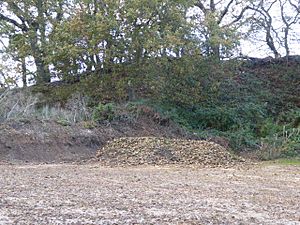Glandford (Letheringsett Road) facts for kids
| Site of Special Scientific Interest | |
 |
|
| Area of Search | Norfolk |
|---|---|
| Interest | Geological |
| Area | 1.1 hectares (2.7 acres) |
| Notification | 1992 |
| Location map | Magic Map |
Glandford (Letheringsett Road) is a special place in Norfolk, England. It's a small area, about the size of two football fields (1.1 hectares or 2.7 acres), that's important for understanding Earth's history. It's officially known as a Site of Special Scientific Interest (SSSI) because of its unique geology. This means it's protected by law to keep its natural features safe.
This site is also part of the Norfolk Coast Area of Outstanding Natural Beauty, which is a special area recognized for its beautiful landscapes. It's also a Geological Conservation Review site, meaning it's one of the best examples of geological features in Great Britain.
Why Glandford (Letheringsett Road) is Important
This site helps scientists learn about how our planet changed a long time ago. It has special mounds made of gravel and a type of clay called till. Till is a mix of clay, sand, and rocks that was left behind by huge sheets of ice, called glaciers, during the Ice Ages.
Understanding Ancient Ice Ages
The gravel and till at Glandford (Letheringsett Road) are like clues from the past. They help experts figure out if the flat land in North Norfolk was formed by glaciers dropping off these materials (this is called glacial deposition). Or, they might show if the land was shaped by the slow wearing away of a much larger area of gravel (this is called erosion).
Scientists study these mounds to understand the Pleistocene epoch. This was a period in Earth's history, from about 2.6 million to 11,700 years ago, when much of the world was covered by glaciers. By studying sites like this, we can learn more about how glaciers moved and shaped the land we see today.
Visiting the Site
It's important to know that Glandford (Letheringsett Road) is on private land. This means there is no public access, so you cannot visit it. However, its protection helps scientists continue to study and learn from its unique geological features.

